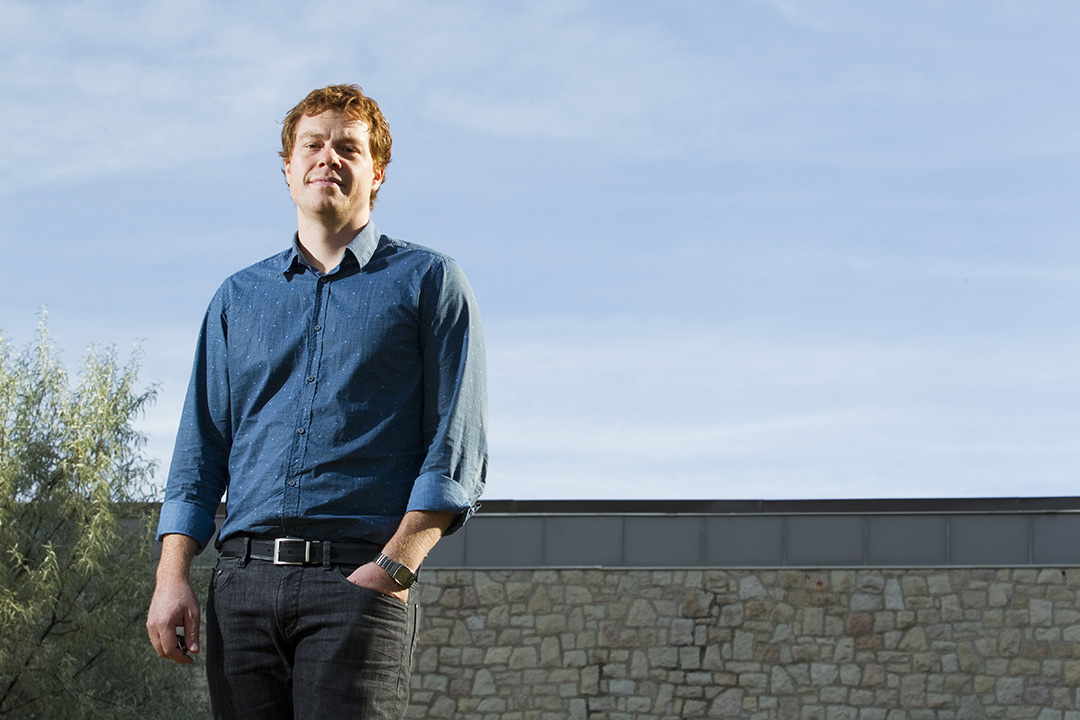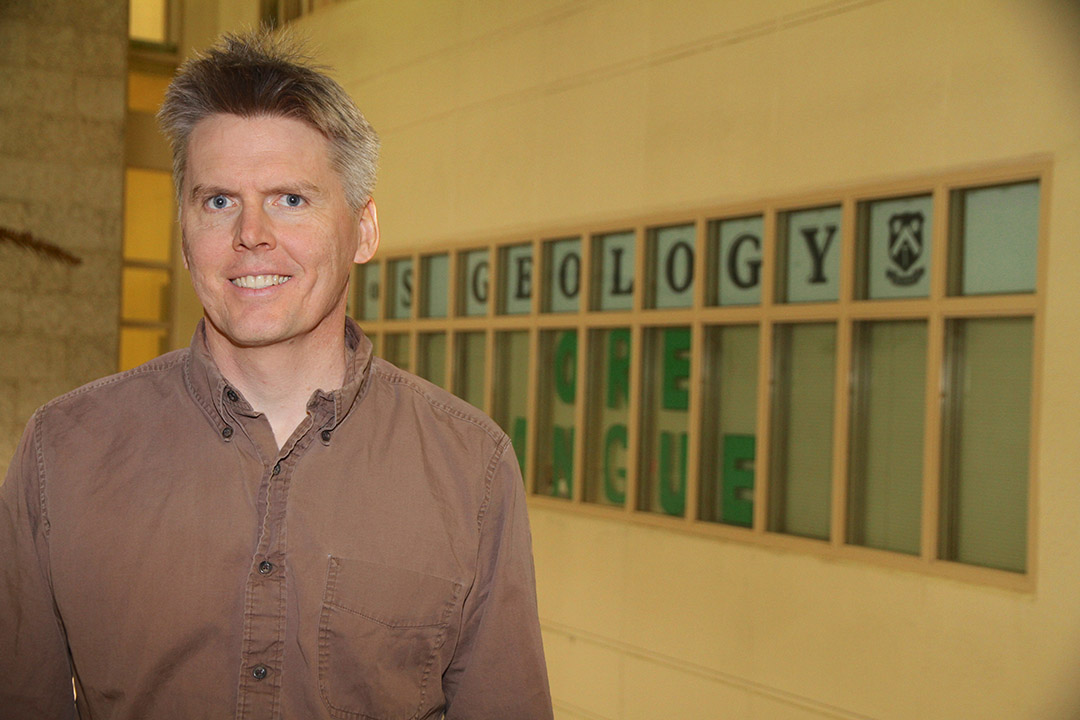Earthquakes and eruptions
Researchers can’t predict when the next cataclysmic natural disaster is going to occur, but Adam Bourassa can give you a good idea of how it could affect us.
By James ShewagaThe University of Saskatchewan professor of physics and engineering physics is a member of the university’s Institute of Space and Atmospheric Studies and has been studying the effects on earth’s atmosphere and climate, from volcanic eruptions halfway around the world to wildfires in Western Canada. A U of S-led project—the Optical Spectrograph and InfraRed Imaging System (OSIRIS)—originally designed to operate for two years aboard a Swedish satellite, is still functioning almost perfectly 17 years later and downloading data daily.
“It is quite amazing,” said Bourassa. “Because it has lasted so long and the data quality is so high, it has become really important for climate research.”
Bourassa’s findings, published in 2015 in the journal Science, confirmed that even small eruptions can launch aerosols—fine particles and volcanic gasses—more than 10 kilometres up into the stratosphere where they can linger for years, shielding sunlight and cooling temperatures world-wide.

“With OSIRIS we have seen about 10 volcanic eruptions reach the stratosphere and the climate impact of those smaller eruptions has been relatively small, but they can’t be ignored if we want to truly understand what is happening with global warming and climate change,” said Bourassa. “It also gives us an idea of what could happen in the event of a much more serious eruption like Mount Pinatubo.”
The 1991 Pinatubo eruption in the Philippines was the largest in our lifetime, killing nearly a thousand people, destroying or damaging 80,000 homes, devastating crops, dramatically affecting air quality and delivering a billion-dollar blow to the country’s economy. The eruption injected 17 million tons of sulfuric acid into the atmosphere—the largest amount ever recorded—depleting the ozone layer and causing global temperatures to drop an average of half a degree Celsius for more than a year.
“We are always on the watch for another Mount Pinatubo-sized eruption and we never really know when it is coming, but there is usually one of that size every few decades,” said Bourassa. “Those big eruptions, like Pinatubo in 1991 and two in the 1800s, Krakatoa (1883) and Tambora (1815), were associated with cooling of the climate, which can affect crop production. The period after the Tambora eruption was called ‘a year without summer’ as wine production in France failed and crops were affected world-wide.”
More recently, the 2010 Eyjafjallajökull volcanic eruption in Iceland created an ash plume that carried into the jet stream (nine to 16 km above sea level), resulting in a week-long shutdown of all air travel in Europe and more than 100,000 flights cancelled. Closer to home, U of S researchers are now studying data from the 2017 wildfires in British Columbia.
“The big forest fires in B.C. in August last year were so intense and strong enough that the smoke actually reached the stratosphere and lasted until January,” said Bourassa. “And that was unprecedented. We had never seen that before.”
The B.C. coast is also an active earthquake region with a string of 18 largely dormant—but not extinct—volcanoes, which could cause a catastrophic event. While the last volcanic eruption in Canada occurred 150 years ago at Lava Fork in northern B.C., Mount St. Helens in the state of Washington just south of the border erupted in 1980 with 1.5 million tons of sulfuric acid billowing into the atmosphere and volcanic ash falling across Western Canada, reaching as far as Saskatchewan.

“Mount St. Helens is obviously the one that went off most recently, but there is a series of volcanoes down the West Coast and I don’t believe any of them are entirely dead,” said professor Samuel Butler, the head of the Department of Geological Studies at the U of S. “Mount Hood (Oregon), Mount Shasta (California), even Mount Garibaldi in British Columbia could potentially go off at any time.”
A 10-hour drive south of Saskatoon, Yellowstone National Park in Wyoming is home to a massive underground supervolcano that lets off steam—literally—through active geysers, hot springs and bubbling mud ponds. Its eruption would be 2,000 times stronger than Mount St. Helens, killing millions and causing worldwide famine from an ash cloud that would circle the globe. However, Yellowstone last erupted an estimated 600,000 years ago and there aren’t signs of any imminent eruption, according to Butler.
Of more immediate concern to Canada is the catastrophic damage that would be caused by a major West Coast plate tectonics earthquake and the resulting ocean tsunami—like the one that led to the Japanese Fukushima nuclear reactor disaster in 2011. Butler explained that the Juan de Fuca plate from Vancouver Island down to California is slowly slipping underneath the North American plate, creating the potential for massive earthquakes. Experts agree it’s not a case of if, but when, the next massive West Coast earthquake will occur.
“We know that a very large earthquake, probably a magnitude nine (on the Richter Scale), happened in the 1700s, so it’s a timescale of hundreds of years,” said Butler, whose department covers earthquake seismology and volcanic eruptions in undergraduate courses GEOL 108, 121, 282, and 406. “The next one could happen this afternoon, or it might not happen for another 300 years.”
According to Natural Resources Canada and the Geological Survey of Canada, there is a 30 per cent chance that B.C. will suffer a major earthquake in the next 50 years. A 9.0 quake would prove devastating along the coast, causing numerous fatalities and infrastructure damage, and affecting the economy of the entire country. Better construction standards adopted in the past few decades have helped prepare structures for the next big quake, but scientists are still searching for ways to provide earlier warnings of impending earthquakes and volcanic eruptions.
“Certainly in the seismic realm, the Holy Grail would be the ability to accurately predict earthquakes, and researchers have put quite a lot of effort into it and not had a lot of success,” said Butler. “With volcanoes, by monitoring increasing seismic activity, experts are a little bit better at saying yes, there is going to be an eruption in the next day or two. Whereas with earthquakes, we just can’t say that. We know where dangerous earthquakes are likely to happen, but we can’t say when. So, that’s the challenge for researchers.”

